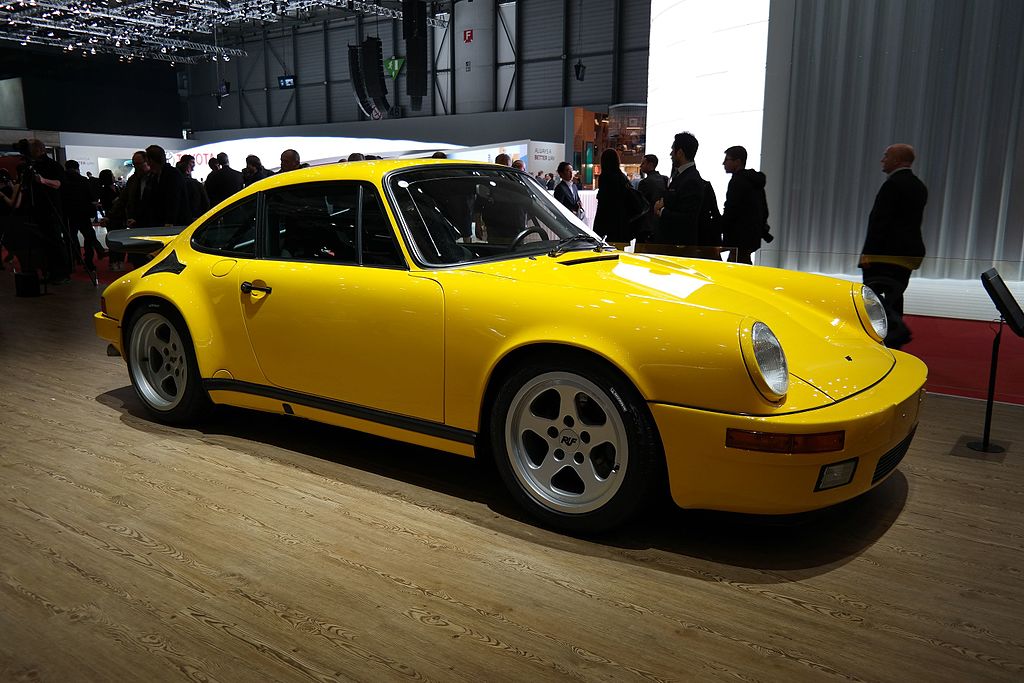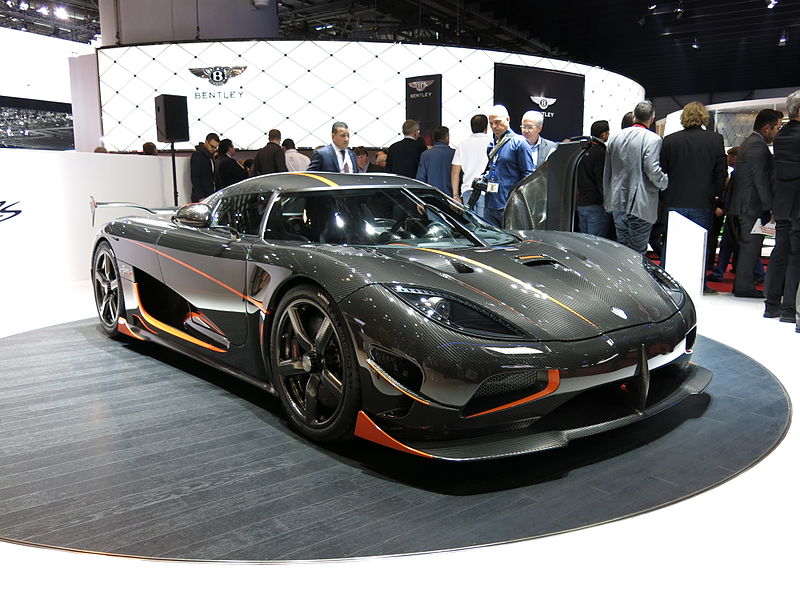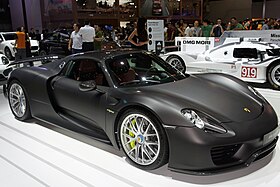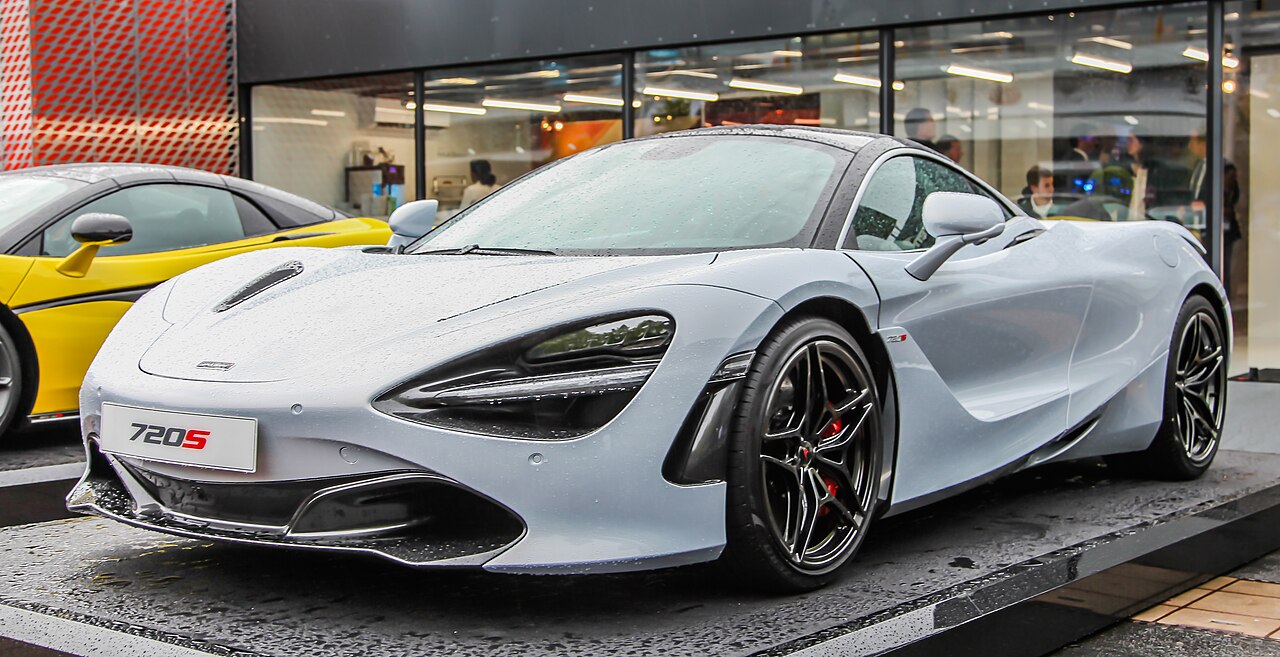The Ruf CTR (Group C, Turbo Ruf) also known as the CTR Yellowbird or simply Yellowbird, was a limited-production, high performance sports car manufactured by Ruf Automobile of Germany.
Introduced for the 1987 model year and based on the Porsche 911, the CTR featured an enlarged and highly tuned version of Porsche's 3.2 litre flat-six cylinder engine, lightened body panels, an integrated roll cage (adding chassis stiffness in addition to occupant safety), upgraded suspension and braking systems, a custom-designed transmission, and several unique trim pieces such as polyurethane bumpers, and the use of the side mounted oil filler (a Porsche feature for the 1972 MY only) necessitated by relocating the oil tank forward to clear the intercooler on that side.
The car received its nickname, "Yellowbird", during testing by Road & Track magazine, whose staffers noted the contrast created by its yellow paintwork against the overcast skies on the day of their photo shoot.[History
CTR2 engine view with Alois Ruf
The CTR (abbreviation of "Group C Turbo Ruf") was based on the 1987 911 Carrera 3.2 as opposed to the 930, Porsche's factory turbocharged version of the 911, a decision made because of the 3.2's slightly lower curb weight and drag coefficient. Factory body panels including the doors, hood and engine cover were replaced with aluminum pieces, helping to knock an additional 200 kg (441 lb) off the vehicle's factory curb weight. Shaved rain gutters to reduce drag, fiberglass front and rear bumpers and a pair of intake ducts on the rear flares to allow airflow to the intercoolers topped the list of body modifications. The rear arches were also increased in width very slightly to accommodate the larger Speedline wheels.
In addition to the lighter panels, considerable modifications were made to the engine, including boring the cylinders out to 98 mm (3.86 in) to increase displacement from 3.2 L; 193.1 cu in (3,164 cc) to 3.4 L; 205.5 cu in (3,367 cc), adding an uprated Bosch Motronic 2.1 fuel injection system, and switching to the ignition setup originally designed for the Porsche 962 race car. A specifically designed turbo system featuring large twin-turbochargers and twin intercoolers topped the engine work, bringing total output to 469 PS (345 kW; 463 bhp) at 5950 rpm and 553 N⋅m (408 lbf⋅ft) of torque at 5100 rpm. The sound from the blow-off valve was also curiously close to the chirp of a canary, helping the name "Yellowbird" stick.[citation needed]
Ruf CTR Yellowbird powerplant.
At the time, Porsche offered the 911 3.2 with a 5-speed manual transmission, but the 930 featured only a 4-speed transmission, chosen because it was the only unit manufactured by the company that could handle the turbocharged engine's high output. Not content with only four forward gears and unable to satisfactorily modify the 5-speed unit, Ruf chose to use a new five-speed transmission of their own design on the CTR, which also gave them full freedom to customize gear ratios. To ensure absolute control, an upgraded suspension system, 17 inch Ruf Speedline alloy wheels, 330 mm (13.0 in) diameter Brembo braking system, and Dunlop's Denloc system performance tires were used.
The company debuted the vehicle at the end of 1987 with pricing set at $223,000 per unit, although that number could vary depending on whether a given customer ordered their car directly from Ruf or brought in a unit purchased via dealer for conversion. Ruf made only 29 CTRs from chassis bought from Porsche; about 20-30 were built from customers' Carreras.[3]
Specifications
Ruf rated the CTR at 469 PS (345 kW; 463 hp) and 408 lb⋅ft (553 N⋅m) of torque. It is said that the power output of 469 PS (345 kW; 463 hp) was the lowest dynamometer reading of all the CTR engines tested while the average figure was closer to 507 PS (373 kW; 500 hp) or even higher.[3][4][2]
Much attention was given to aerodynamic considerations, with the body being de-guttered/seam welded and the use of filler panels for the door pillars and 935-style mirrors. Prototype models had NACA-style intercooler intake ducts over the rear fenders (later dropped, as it was discovered that air was pulled out, rather than in, at speed due to a low-pressure area), while later models had additional slots in the rear bumper corners for the air to exit.
Weighing in at 2,535 lb (1,150 kg), the CTR had a 0–97 km/h (0–60 mph) acceleration time of 3.65 seconds and a top speed in excess of 338 km/h (210 mph). Although the Porsche 959 was faster in terms of acceleration to 97 km/h (60 mph), the Yellowbird could outperform all competition when it came to top speed, topping out at 342 km/h (213 mph), a top speed that made it the fastest production car in the world at the time of its introduction.[3][5][6]
Technical specifications[7][8]
Engine configuration: Twin-turbocharged SOHC 2 valves per cylinder flat-six engine
Bore X Stroke: 98 mm × 74.4 mm (3.86 in × 2.93 in)
Displacement: 3,367 cc (3.4 L; 205.5 cu in)
Compression ratio: 7.5:1
Power: 469 PS (345 kW; 463 hp) at 5,950 rpm
Torque: 553 N⋅m (408 lb⋅ft) at 5,100 rpm
Redline: 6,800 rpm
Curb weight: 1,150 kg (2,535 lb)
Gearbox: 5-speed manual transmission (6-speed optional)
Tyres: 215/45ZR-17 front, 255/40ZR-17 rear
Layout: Rear-engine, rear-wheel-drive.
Performance
Interior
The Recaro seats in a CTR
The CTR could generally outperform most of the other high performance cars of the time, including the Ferrari Testarossa and Lamborghini Countach.[9] In addition, despite being slower than the Porsche 959 in accelerating from 0-60 mph (97 km/h), it could outperform the Porsche 959, Ferrari F40 and the Lamborghini Diablo accelerating from 0-160 km/h (99 mph) and attain a higher top speed.[2][6]
The CTR was also a highly competent track vehicle, and for several years it held the unofficial lap record at the Nürburgring-Nordschleife track.[10]
Test results by Autocar:
0–48 km/h (30 mph): 1.69 seconds [5]
0–97 km/h (60 mph): 3.65 seconds [5]
0–161 km/h (100 mph): 6.71 seconds [5]
0–241 km/h (150 mph): 14.59 seconds [5]
0–322 km/h (200 mph): 35.57 seconds [5]
Standing mile: 27.7 seconds at 304.34 km/h (189.11 mph) [5]
0–161–0 kph: 11.85 seconds [5]
0–322–0 kph: 47.20 seconds [5]
Test results by other magazines:
0–100 km/h (62 mph): 4.1 seconds [1]
0–200 km/h (124 mph): 10.5 seconds [11]
Standing 1/4 mile: 11.7 s at 215 km/h (133.5 mph)[9]
0–1,000 m: 20.9 seconds [1]
Top speed: 342 km/h (213 mph) [6]
Other Media
The Ruf CTR had its first appearance in April 1987 at the "World's Fastest Cars" contest held by American car magazine Road & Track where it was designated "The Fastest Production Car in the World". It did 0-60 mph (97 km/h) in 4.0 seconds, 0-100 mph (161 km/h) in 7.3 seconds, 0-124.3 mph (200 km/h) in 10.5 seconds, 1⁄4 mile (402 m) in 11.7 seconds at 133.5 mph (215 km/h) and reached a top speed of 211 mph (340 km/h), beating the competition by 10 mph (16 km/h). Paul Frère shouted "This is faster than I've ever gone in my life!" during a ride.[9][12][11]
In 1988, Auto motor und sport organized a high speed test at Nardò Ring where the Ruf CTR was the fastest reaching 342 km/h (213 mph), surpassing a Porsche 959 s (339 km/h (211 mph)), two Ferrari F40s (321 km/h (199 mph) each) and a Mercedes AMG 6.0 32V (288 km/h (179 mph)). At one point it achieved an unofficial 215 mph (346 km/h).[6][12]
In 1989, test driver Stefan Roser drove the CTR around the Nürburgring. The laps were captured on camera and released by Ruf in a video called "Faszination on the Nürburgring".[4]
In 2004, an old Ruf CTR was able to keep up with new supercars like Porsche Carrera GT, Enzo Ferrari and Mercedes-Benz SLR McLaren at the Autocar 0-100-0 challenge and impressed the audience,[5] so did another one - with more than 100,000 kilometers on its odometer - at the Road & Track standing mile contest 2005. Steve Millen, after testing a CTR, stated: "That thing's a blast. It accelerates hard. It's a real old-school car with a lot of torque and power. Just awesome. What a rush. It pulled the whole way through."[13]
The Ruf CTR is a playable/drivable car in the video games "The Duel: Test Drive II", "Project Gotham Racing 3", "Project Gotham Racing 4", "Driver: San Francisco", "Forza Motorsport 4", "Forza Horizon", "Assetto Corsa", "Project CARS", and most of the "Gran Turismo" series games.
Successor
The CTR was succeeded in 1996 by the CTR2 based on Porsche's newer 993 Generation 911.
Revival
2017 Ruf CTR on display at the Geneva Motor Show
At the 87th Geneva Motor Show held from 9 to 19 March 2017, exactly 30 years after the original CTR was launched, Ruf presented a new model paying tribute to the original CTR. The new CTR utilises an in-house developed carbon fibre body bearing resemblance to a Porsche 964 along with an aluminium chassis resulting in a dry weight of 2,640 lb (1,197 kg). The car is not 911 based unlike the original CTR. The new CTR is powered by a 3.6-litre water cooled twin-turbocharged Flat-6 engine producing 700 hp (710 PS; 522 kW) at 6750 rpm and 880 N⋅m (649 lb⋅ft) of torque at 4000 rpm.[14] The car is capable of accelerating from 0–100 km/h (0–62 mph) in just under 3.5 seconds and can reach a top speed of 360 km/h (224 mph). The car also sports retro components based off the original CTR such as the 'whale tail' rear wing, five-spoke wheels, interior and the steering wheel. Only 30 examples of the 2017 CTR will be produced with each car costing €750,000.[15]


.jpg/1024px-2015_Koenigsegg_One-1_(19706358889).jpg)

.jpg/220px-Agera_(7464076462).jpg)
%2C_5._April_2012%2C_D%C3%BCsseldorf.jpg/280px-Bugatti_Veyron_16.4_%E2%80%93_Frontansicht_(3)%2C_5._April_2012%2C_D%C3%BCsseldorf.jpg)

_(cropped).jpg/1280px-Mercedes-Benz_SLR_McLaren_(8615973055)_(cropped).jpg)
%2C_30._August_2012%2C_D%C3%BCsseldorf.jpg/1280px-McLaren_MP4-12C_%E2%80%93_Frontansicht_(3)%2C_30._August_2012%2C_D%C3%BCsseldorf.jpg)



.jpg/1024px-McLaren_P1_GTR_(16699880902).jpg)


.jpg/220px-FoS20162016_0625_104435AA_(27826166951).jpg)
